Case Report
Integrative Medicine Case Reports, Volume 3, Issue 2 (July), 2022
The efficacy of selected acupuncture points UB 2, TW 23, GB 37, GB 1, EX 3, on myopia – case report
Tamilarasi G.*, N. Mangaiarkarasi and L. Anto Princy
Acupuncture and Energy Medicine, Government Yoga and Naturopathy Medical College and Hospital, Chennai, Tamilnadu, India
| |
|
|
KEY WORDS |
|
ABSTRACT |
Myopia
Acupuncture |
|
Myopia is a community health problem worldwide. The cause of myopia is both equally environmental and genetic risk factors. It occurs in more than 50% of the people in many developed countries and is approximate to be very high; the risk associated with axial elongation from myopia is the 6th foremost leading cause of blindness. People with undiagnosed short-sightedness including eyestrain and headache from stress clearly glimpse things in space. Short-sightedness also can be the outcome of the vision outermost of the cornea that is too curved for the level of the eyeball or a lens that is too solid. Acupuncture is one of the oldest and most typically used balancing and opportunity scientific treatments around the globe. Acupuncture is the training of inserting and manipulating needles into the superficial skin, subcutaneous tissue, and mucks of the body at specific acupuncture points.This study aims to find the effect of acupuncture points on vision and the power of the lens in people with myopia.
doi: 10.38205/imcr.030251 |
*Corresponding Author:
Tamilarasi G.
Government Yoga and Naturopathy
Medical College and Hospital,
Chennai, Tamilnadu, India
Contact no: +91-9176881735
E-mail: gtamilbnys@gmail.com |
Introduction
Myopia, also known as near-sightedness or short-sightedness, is an incredibly ordinary condition. The prevalence of short-sightedness or myopia has been increasing significantly over the past few decades and also the prevalence of myopia in offspring varies in unusual areas and countries. Myopia starts during childhood and can be generally calculated from the incidence of different age populations (1). High prevalence in younger age groups directs to a bigger burden and severity of myopia in adulthood. It is particularly prevalent in the urban areas of East and Southeast Asia and is particularly prevalent in the municipal areas of south and East Asia. According to the World Health Organization, distribution of myopia is not equal in different countries and age groups. The incidence of myopia in children is 11.7% and ranged from 4.9% in Southeast Asia to 18.2% in the Western Pacific Region. The prevalence of myopia in adults was 26.5% and ranged from 16.2% in the Americas to 32.9% in Southeast Asia. Myopia is associated with many genes each affecting a different part of the pathways which influence eye growth. Even though a gene location for high myopia has been identified, there are no conclusions about a possible gene location for moderate levels of myopia (3). Several genetic and environmental factors have been associated with the development of myopia, while a possible interaction of these conditions has also been supported (4). Acupuncture is extremely valued in traditional Chinese medicine and enjoys a good history of more than 2,500 years. The points present beside the meridian in the body are known as acupuncture points (5). In 1980, the World Health organization recommended acupuncture as an effective alternative therapy (6) and it is a medical system of healing based on the theory of the application of the small fine needle, regularly stainless steel, and bendable needles ranging from 10 to 100 mm or applies certain pressure over the specific points in the body. The points present beside the meridian in the body are known as acupuncture points. The essential energy, Qi flows along the meridian in a healthy individual. According to traditional Chinese medicine (TCM), the five elements viz; wood, water, fire, earth, and metal are responsible for the flow of Qi in the human body (7). This system is a unique ophthalmology-specific method that combines traditional “Five Orbiculi” differentiation by means of syndromes pertaining to the invasion of the eyes by extreme evil Qi. Syndromes related to invasion of the eyes by extreme evil Qi include invasion of the eyes by wind-heat, invasion of wind-cold pathogens into the eyes, invasion of the eyes by wind-dampness, exterior injury of the ocular vessel, and pattern/syndrome of worm accumulation transforming into malnutrition (8). Numerous studies have confirmed acupuncture. In the treatment of young person’s myopia, but nearly all studies use visual acuity as the primary outcome measure. Which can easily inclined by many external factors (9). The present case study was done to find the effect of selected acupuncture points on visual acuity and refractive error in myopia. Acupuncture has been confirmed to be a safe therapy with a very low risk of serious Side effects. On 1979, May 11, Susan Wang M.D and Renald ching M.D conduct a study on the effect of acupuncture in ophthalmology and found a study reported that a significant effect on vision (10). Yanlin Zheng, Qun Huang, Yang Yang, and Hui Huang have shown an improvement in myopia using acupuncture points around the eyes refered to as sizhukong, Tongziliao, and Sibai in a study RCT and single-blind study (11).
Case presentation
A 20 years old male (A) visited our Government yoga and naturopathy medical college and hospital with the complaint of blurred vision and difficulty seeing distant objects. Also, he was the known case of myopia for the past four years. His condition got aggravated while using computer for a long time process. He was diagnosed by an ophthalmologist to be having myopia with increased eye power. The person attended our hospital outpatient for the three weeks. He was given with informed consent. The intervention of acupuncture treatment for duration of twenty minutes daily six days a week for three weeks. The pre-test was taken before the acupuncture treatment and post-test was assessed after 3 weeks of intervention.
Intervention
Subject was treated with the sterile acupuncture needle that penetrates along the skin for the duration of 20 minutes (6 days/week), for 3 weeks. Assessments were be done before and after the intervention.
Point |
Location |
Image |
UB 2 |
At the inner end of the eyebrow directly above the medial canthus of the eye |
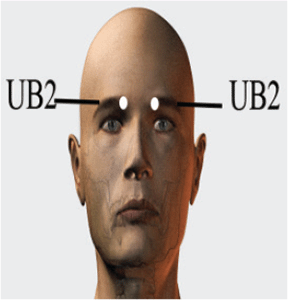
|
TW 23 |
The Lateral end of the eyebrow |
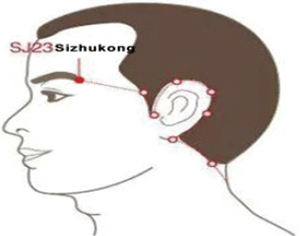
|
GB 37 |
5 t-sun above the tip of lateral malleolus in front of the fibula |
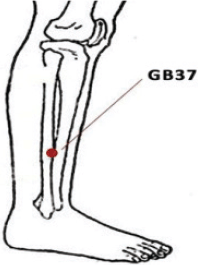
|
GB 1 |
0.5 t-sun lateral to the lateral canthus of the eye |
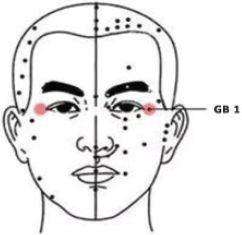
|
EX 3 |
The Midpoint of the eyebrow, in the line of the pupil |
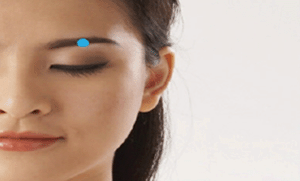
|
The study was conducted to find the effect of acupuncture on myopia. To investigate using some acupuncture points to improve visual acuity and refractive power. The intervention was given to participants wherein data was extracted at the baseline (Table 1) and post-intervention after 3 weeks (Table 2). Acupuncture shows the tendency to improve visual acuity and refractive power as evident by results.
Table 1: Pre Test Report
Parameters |
Pre Test |
Pre test |
Right eye |
Left eye |
Sphere |
Cylinder |
Sphere |
Cylinder |
Refractive power (D) |
2.00 |
0.50 |
0.50 |
0.50 |
Visual Acuity |
6/6 |
6/6 |
6/6 |
6/6 |
Table 2: Post Test Report
Parameters |
Post Test |
Post test |
Right eye |
Left eye |
Sphere |
Cylinder |
Sphere |
Cylinder |
Refractive power (D) |
1.50 |
– |
0.50 |
– |
Visual Acuity |
6/6 |
6/6 |
6/6 |
6/6 |
Discussion
The present study was adopted to explore effects of the combination of specific acupuncture points in improving the visual acuity and refractive power in myopia. The results showed that intervention had significant effect on the visual acuity and refractive power in myopia. Myopia is also called the syndrome of the inability of seeing far in traditional Chinese Medicine. Its etiology, terminology, and treatment prescription are already stated in the classic book Qian Jin Yao Fang by Sun Simiao of the Tang Dynasty (618–907). In Traditional Chinese Medicine (TCM), according to the author Huang Di Nei Jing Su Wen Yu Yi, suggest that myopia can be caused by congenital deficiency, mal-development after birth, weakness of the Spleen, Liver, and Kidney, plus inappropriate use of the eyes.
The main function of the spleen is to disperse the energy into all the internal organs. So the weakness in the spleen explains the disruption in the flow of qi which in turn result in blood stasis and qi stagnation caused in the collaterals of the eye, as well as a lack of nourishment of the eye. At the same time, uprising of excessive yang, qi causes disruption in the balanced qi flow and basically liver opens in the eye. The origin of short-sightedness is related to factors such as feeling overstrain of the eye, fatigue, and improper food intake; this causes syndromes such as Kidney and Liver deficiency, Spleen Qi deficiency, and Heart yang deficiency. The points used here lay urinary bladder meridian, Triple warmer, and gall bladder meridian pass via the eye when needling on this point helps to remove the stagnation. This may be the possible mechanism. The meridian is the pathway for the body surface to connect and interact with the internal organs and the acupuncture point is a specific point on the meridian, forming a special function relationship with the corresponding viscera and the related surface structure through the meridians.Therefore, TCM purports that ‘the meridian circulation is closely related to the amount of meridian Qi concentrated’.
An additional way, acupuncture improves visualization by exciting the ocular nerve cells (optic nerve, retina, and ganglia etc.). If Nerve cells are not being nourished properly can become inactive and go into a dormant state. Acupuncture can provoke dormant nerve cells, often resulting in an improvement in visual acuity. If the person has more dormant cells, the greater the improvement. Acupuncture can also help to improve vision related to myopia and hyperopia by strengthening overall circulation and the flow of energy to the muscles of the eyes (12).
A few studies suggested that acupuncture at visual-related acupoints could modulate optical physiology (13). Therefore, in a proposed study the local points (Zanzhu, Sizhukong, Guangming, Tonziliao, and Yuyao) will be acupunctured simultaneously, and the clinical efficacy of acupuncture in myopia will be determined.
Limitations of the study
The current study was done with a minimum number of subjects with 6 days a week for a period of 3 weeks, and further follow up was done in the study.
Conclusion
Acupuncture has a tendency to improve vision loss due to myopia. The results of the present study suggest that the 3 weeks of acupuncture treatment for a person with myopia had a significant effect on right and left eyes of all the factors. Advanced studies with longer interval may be adopted in a well-built population in future.
Acknowledgments
I thank Dr. N. Mangaiarkarasi H.O.D. Deptartment of Acupuncture and Energy Medicine, GYNMC, Chennai, for her constant support and motivation all the way.
Authors’ contribution
TG: Performed the Analysis and Writing
NM: Writing – reviewing and editing
LP: Reviewing and editing
Informed consent form
Yes.
Source of funding
Nill.
Conflict of interst
Nil.
Received Date: 18-03-22; Revised Date: 21-07-22
Accepted Date: 28-07-22
Referrences
1. Verhoeven VJ, Hysi PG, Wojciechowski R, Fan Q, Guggenheim JA, Höhn R, et al. Genome-wide meta-analyses of multiancestry cohorts identify multiple new susceptibility loci for refractive error and myopia. Nat Genet. 2013;45(3):314-8. https://doi.org/10.1038/ng.2554
2. Wolfram C, Höhn R, Kottler U, Wild P, Blettner M, Bühren J, et al. Prevalence of refractive errors in the European adult population: The Gutenberg Health Study (G0HS) Br J Ophthalmol. 2014;98:857–61.
3. Ramamurthy D, Lin Chua SY, Saw SM. A review of environmental risk factors for myopia during early life, childhood and adolescence. Clin Exp Optom. 2015. Nov;98(6):497–506.
4. Light exposure and physical activity in myopic and emmetropic children. Read SA, Collins MJ, Vincent SJOptom Vis Sci. 2014 Mar;91(3):330–41.
5. E. Dolgin, “e myopia boom,” Nature. 2015;519(7543):276–278.
6. Chang S. The meridian system and mechanism of acupuncture a comparative review. Part 1: the meridian system. Taiwan J Obstet Gynecol. 2012;51:506–514. https://doi.org/10.1016/j.tjog.2012.09.004
7. Van Hal M, Huecker MR, Green MS. Acupuncture. In: StatPearls [Internet]. Treasure Island (FL): StatPearls Publishing; 2020 [cited 2020 Apr 24]. Available from: http://www.ncbi.nlm.nih.gov/books/NBK532287/
8. Meng W, Butterworth J, Malecaze F, Calvas P. Axial length of myopia: a review of current research. Ophthalmologica. 2011;225:127–134. https://doi.org/10.1159/000317072
9. Wong S, Ching R. The use of acupuncture in ophthalmology. Am J Chin Med. 1980 Spring-Summer; 8(1–2):104-53. https://doi.org/10.1142/s0192415x80000098. PMID: 7395794
10. Huang, Qun MM; Yang, Yang MB; Huang, Hui MM; Zheng, Yanlin MM; Wang, Wanjie MM; et Clinical study on acupuncture acupoints around the eyes in treating myopia in children and adolescents, Medicine: October 23, 2020;99(43):e22659. https://doi.org/10.1097/MD.0000000000022659
11. Acufinder.com/Acupuncture+Information/Detail/Understanding+Vision+Problems+through+Traditional+Chinese+Medicine
12. Pacificcollege.edu/news/blog/2015/03/05/reaching-optimal-eye-health-with-chinese-medicine.
13. Hua L, Jianyang X, Baoci S, Yongzhong L, Lin L, and Jingquan X, Binbin N: Determining the precise cerebral response to acupuncture: an improved fmri study. PLoS One. 2012;7:e49154. https://doi.org/10.1371/journal.pone.0049154. Article Google Scholar




